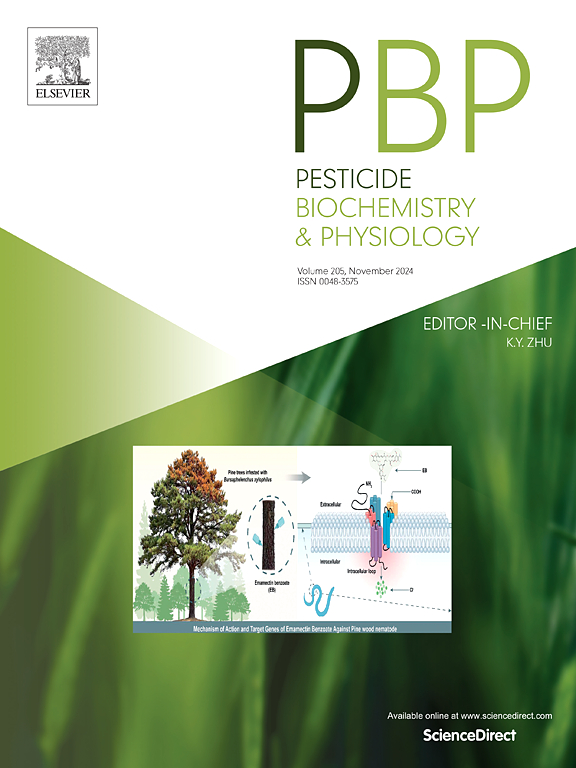The Trp-574-Leu mutations together with enhanced metabolism contribute to cross-resistance to ALS inhibiting herbicides in Fimbristylis littoralis
IF 4.2
1区 农林科学
Q2 BIOCHEMISTRY & MOLECULAR BIOLOGY
引用次数: 0
Abstract
Fimbristylis littoralis Gaudich., an important weed in Chinese paddy fields, has caused significant yield losses in rice and other crops. Acetolactate synthase (ALS) inhibitors, such as halosulfuron-methyl, are widely used for weed control. This study identified a highly resistant population (R23–1) of F. littoralis to halosulfuron-methyl, with an exceptionally high resistance index (RI) of 3441.66. The resistant mechanisms of F. littoralis to ALS inhibitors have not been reported previously. We employed a comprehensive approach to address this, including whole-plant bioassay, ALS target gene sequencing, molecular docking, synergistic tests with metabolic enzyme inhibitors, glutathione S-transferases (GSTs) activity assays, and cross-resistance testing. The results revealed the first report of a Trp-574-Leu mutation in the ALS gene of the R23–1 population, which significantly increased binding energy, as shown by molecular docking analysis. Synergistic tests demonstrated that the cytochrome P450 monooxygenase (P450) inhibitor piperonyl butoxide (PBO) and the GSTs inhibitor 4-chloro-7-nitro-1,2,3-benzoxadiazole (NBD-Cl) markedly enhanced the sensitivity of the R23–1 population to halosulfuron-methyl, with synergistic ratios of 4.11 and 8.15, respectively, while malathion had no effect. GST activity decreased in both populations after halosulfuron-methyl treatment, with the R23–1 population consistently showing significantly higher levels, peaking on day five. Furthermore, the R23–1 population demonstrated cross-resistance to multiple ALS inhibitors. These findings provide novel insights into the resistance mechanisms of F. littoralis and lay a theoretical foundation for developing effective strategies to mitigate or delay the evolution of resistance.

Trp-574-Leu突变与代谢增强共同促进了滨金缕草对ALS抑制除草剂的交叉抗性
【摘要】沿海金缕草。它是中国稻田中的一种重要杂草,对水稻和其他作物造成了重大的产量损失。乙酰乳酸合成酶(ALS)抑制剂,如卤代磺隆-甲基,被广泛用于杂草控制。本研究鉴定出一个高抗性种群(R23-1),抗性指数(RI)为3441.66。滨海梭菌对ALS抑制剂的耐药机制此前未见报道。我们采用了全面的方法来解决这个问题,包括全植物生物测定,ALS靶基因测序,分子对接,与代谢酶抑制剂的协同试验,谷胱甘肽s-转移酶(GSTs)活性测定和交叉抗性试验。结果首次报道了R23-1群体ALS基因中Trp-574-Leu突变,分子对接分析显示,该突变显著增加了结合能。增效试验表明,细胞色素P450单加氧酶(P450)抑制剂胡椒酰丁醇(PBO)和GSTs抑制剂4-氯-7-硝基-1,2,3-苯并恶二唑(NBD-Cl)显著增强了R23-1种群对卤代磺隆-甲基的敏感性,增效比分别为4.11和8.15,而malathion无增效作用。在氟磺隆-甲基处理后,两个种群的GST活性均下降,其中R23-1种群的GST活性持续显著升高,在第5天达到峰值。此外,R23-1群体表现出对多种ALS抑制剂的交叉耐药。这些研究结果为研究沿海褐藻的耐药机制提供了新的见解,并为制定有效的策略来减轻或延缓耐药性的演变奠定了理论基础。
本文章由计算机程序翻译,如有差异,请以英文原文为准。
求助全文
约1分钟内获得全文
求助全文
来源期刊
CiteScore
7.00
自引率
8.50%
发文量
238
审稿时长
4.2 months
期刊介绍:
Pesticide Biochemistry and Physiology publishes original scientific articles pertaining to the mode of action of plant protection agents such as insecticides, fungicides, herbicides, and similar compounds, including nonlethal pest control agents, biosynthesis of pheromones, hormones, and plant resistance agents. Manuscripts may include a biochemical, physiological, or molecular study for an understanding of comparative toxicology or selective toxicity of both target and nontarget organisms. Particular interest will be given to studies on the molecular biology of pest control, toxicology, and pesticide resistance.
Research Areas Emphasized Include the Biochemistry and Physiology of:
• Comparative toxicity
• Mode of action
• Pathophysiology
• Plant growth regulators
• Resistance
• Other effects of pesticides on both parasites and hosts.

 求助内容:
求助内容: 应助结果提醒方式:
应助结果提醒方式:


